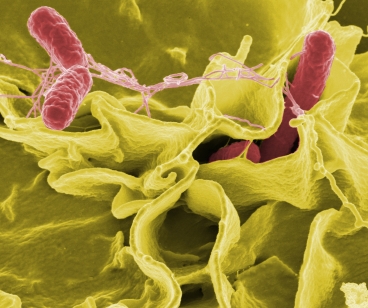Unlike electronic circuits on a silicon chip, biological circuits inside a cell cannot be physically isolated from one another. Because all the cellular machinery for reading genes and synthesizing proteins is jumbled together, researchers have to be careful that proteins that control one part of their synthetic circuit don't hinder other parts of the circuit.
Researchers have now developed circuit components that don't interfere with one another, allowing them to produce the most complex synthetic circuit ever built. The circuit integrates four sensors for different molecules. Such circuits could be used in cells to precisely monitor their environments and respond appropriately.

Biological engineers created new genetic circuits using genes found in Salmonella (seen here) and other bacteria. Image: NIH
"It's incredibly complex, stitching together all these pieces," says Christopher Voigt, an associate professor of biological engineering at MIT. Larger circuits would require computer programs that Voigt and his students are now developing, which should allow them to combine hundreds of circuits in new and useful ways.
Previously, Voigt designed bacteria that can respond to light and capture photographic images, and others that can detect low oxygen levels and high cell density — both conditions often found in tumors. However, no matter the end result, most of his projects, and those of other synthetic biologists, use a small handful of known genetic parts. "We were just repackaging the same circuits over and over again," Voigt says.
To expand the number of possible circuits, the researchers needed components that would not interfere with each other. They started out by studying the bacterium that causes salmonella, which has a cellular pathway that controls the injection of proteins into human cells. "It's a very tightly regulated circuit, which is what makes it a good synthetic circuit," Voigt says.
The pathway consists of three components: an activator, a promoter and a chaperone. A promoter is a region of DNA where proteins bind to initiate transcription of a gene. An activator is one such protein. Some activators also require a chaperone protein before they can bind to DNA to initiate transcription.
The researchers found 60 different versions of this pathway in other species of bacteria, and found that most of the proteins involved in each were different enough that they did not interfere with one another. However, there was a small amount of crosstalk between a few of the circuit components, so the researchers used an approach called directed evolution to reduce it. Directed evolution is a trial-and-error process that involves mutating a gene to create thousands of similar variants, then testing them for the desired trait. The best candidates are mutated and screened again, until the optimal gene is created.
To design synthetic circuits so they can be layered together, their inputs and outputs must mesh. With an electrical circuit, the inputs and outputs are always electricity. With these biological circuits, the inputs and outputs are proteins that control the next circuit (either activators or chaperones).
These components could be useful for creating circuits that can sense a variety of environmental conditions. "If a cell needs to find the right microenvironment — glucose, pH, temperature and osmolarity [solute concentration] — individually they're not very specific, but getting all four of those things really narrows it down," Voigt says.
The researchers are now applying this work to create a sensor that will allow yeast in an industrial fermenter to monitor their own environment and adjust their output accordingly.
Published in Nature




Comments